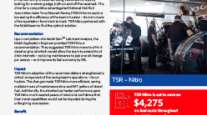Diesel Avg. Falls 2.5¢ to $3.869, Lowest Level Since November
This story appears in the July 28 print edition of Transport Topics.
The U.S. diesel average fell 2.5 cents last week to $3.869 a gallon, the lowest level since just before Thanksgiving, the Department of Energy reported.
Diesel has dropped 5.1 cents in the past three weeks. It has fallen in 10 of the past 12 weeks, but only by a total of 10.6 cents.
The current price is 3.4 cents below the corresponding week last year and the lowest since Nov. 25, when it was $3.844.
DOE also said after its July 21 survey of fueling stations that the retail gasoline average slipped 4.2 cents to $3.593 a gallon, its lowest since March. Gas has dropped 11.1 cents in the past three weeks and is 8.9 cents below a year earlier.
In contrast to this year, diesel was increasing last July, and one analyst said last week that refineries’ high output of the fuel has helped lower prices this year.
“This summer is different from recent summers. U.S. refiners are making plenty of diesel, and Russia has been flooding some overseas markets with diesel,” said Tom Kloza, chief analyst at Oil Price Information Service.
“On top of that, there is more diesel coming from new [and huge] Mideast refineries, and a bit of a more sluggish nature in demand from emerging economies. Throw in lower demand in Europe, some new refining in South America, and you have a recipe for flat or softer prices, rather than the [higher prices] we’ve seen in previous summers.”
One large truckload carrier reported last week it has undertaken multiple means to rein in fuel costs in the second quarter.
“We continue to invest in equipment solutions including more aerodynamic truck features, idle-reduction [and] tire-inflation systems and trailer skirts to improve the mile-per-gallon efficiency of our fleet,” Werner Enterprises said in its second-quarter earnings report, released July 21.
An executive with a much smaller carrier told Transport Topics he does everything from buy fuel in bulk to spec his trucks carefully with truck and engine makers to help keep his fuel bills down.
Roland Bellavance, president of Bellavance Trucking in Barre, Vermont, has a fleet of 140 flatbed, reefer and dry-van units. He said he caps speed at 68 mph, has changed rear-end ratios in an effort to lower rpm and plans to buy new trucks with automated manual transmissions.
“The big fleets are testing this stuff all the time, so [manufacturers] are able to use their numbers to pass down to us little guys,” Bellavance said.
“We’re trying to get a mile a gallon [improvement], which can add up to a million dollars on a 10 million-mile fleet,” Bellavance said. “When every tenth of a mile is $100,000, it doesn’t take long to add up to some sizeable savings.”
Bellavance buys his fuel in bulk for its 15,000-gallon on-site tanks several times a week, and said his $3.59 per gallon wholesale price last week was 28 cents less than the comparable week last year.
Crude oil, meanwhile, held in the $102-$104 per-barrel range last week, up slightly from the two previous weeks but down from a 10-month high of more than $107 in June.
DOE said in a separate report last week that oil supplies fell by 4 million barrels for the week ended July 18. Distillates, which include diesel, rose by 1.6 million barrels, while gasoline inventories increased by 3.4 million barrels.
Kloza said he projects oil to fall into the $90s per-barrel range by the end of the year, which is in line with DOE’s most recent forecast.




